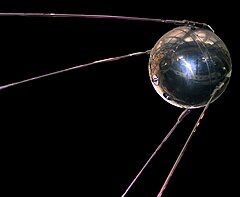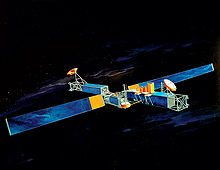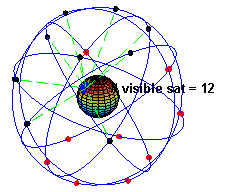
An animation depicting the orbits of GPS satellites in medium earth orbit.
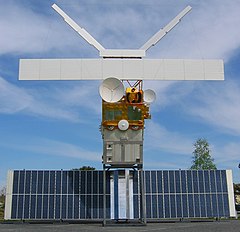
A full size model of the Earth observation satellite
ERS 2 In the context of spaceflight, a satellite is an object which has been placed into orbit by human endeavor. Such objects are sometimes called artificial satellites to distinguish them from natural satellites such as the Moon.
The first artificial satellite, Sputnik 1, was launched by the Soviet Union in 1957. Since then, thousands of satellites have been launched into orbit around the Earth. These originate from more than 50 countries and have used the satellite launching capabilities of ten nations. A few hundred satellites are currently operational, whereas thousands of unused satellites and satellite fragments orbit the Earth as space debris. A few space probes have been placed into orbit around other bodies and become artificial satellites to the Moon, Venus, Mars, Jupiter and Saturn.
Satellites are used for a large number of purposes. Common types include military and civilian Earth observation satellites, communications satellites, navigation satellites, weather satellites, and research satellites. Space stations and human spacecraft in orbit are also satellites. Satellite orbits vary greatly, depending on the purpose of the satellite, and are classified in a number of ways. Well-known (overlapping) classes include low Earth orbit, polar orbit, and geostationary orbit.
Satellites are usually semi-independent computer-controlled systems. Satellite subsystems attend many tasks, such as power generation, thermal control, telemetry, attitude control and orbit control.
History
Early conceptions
The first fictional depiction of a satellite being launched into orbit is a short story by Edward Everett Hale, The Brick Moon. The story is serialized in The Atlantic Monthly, starting in 1869.[1][2] The idea surfaces again in Jules Verne's The Begum's Fortune (1879).
In 1903 Konstantin Tsiolkovsky (1857–1935) published The Exploration of Cosmic Space by Means of Reaction Devices (in Russian: Исследование мировых пространств реактивными приборами), which is the first academic treatise on the use of rocketry to launch spacecraft. He calculated the orbital speed required for a minimal orbit around the Earth at 8 km/s, and that a multi-stage rocket fueled by liquid propellants could be used to achieve this. He proposed the use of liquid hydrogen and liquid oxygen, though other combinations can be used.
In 1928 Slovenian Herman Potočnik (1892–1929) published his sole book, The Problem of Space Travel — The Rocket Motor (German: Das Problem der Befahrung des Weltraums — der Raketen-Motor), a plan for a breakthrough into space and a permanent human presence there. He conceived of a space station in detail and calculated its geostationary orbit. He described the use of orbiting spacecraft for detailed peaceful and military observation of the ground and described how the special conditions of space could be useful for scientific experiments. The book described geostationary satellites (first put forward by Tsiolkovsky) and discussed communication between them and the ground using radio, but fell short of the idea of using satellites for mass broadcasting and as telecommunications relays.
In a 1945 Wireless World article the English science fiction writer Arthur C. Clarke (1917–2008) described in detail the possible use of communications satellites for mass communications.[3] Clarke examined the logistics of satellite launch, possible orbits and other aspects of the creation of a network of world-circling satellites, pointing to the benefits of high-speed global communications. He also suggested that three geostationary satellites would provide coverage over the entire planet.
History of artificial satellites
The first artificial satellite was Sputnik 1, launched by the Soviet Union on October 4, 1957, and initiating the Soviet Sputnik program, with Sergei Korolev as chief designer. This in turn triggered the Space Race between the Soviet Union and the United States.
Sputnik 1 helped to identify the density of high atmospheric layers through measurement of its orbital change and provided data on radio-signal distribution in the ionosphere. The unanticipated announcement of Sputnik 1's success precipitated the Sputnik crisis in the United States and ignited the so-called Space Race within the Cold War.
Sputnik 2 was launched on November 3, 1957 and carried the first living passenger into orbit, a dog named Laika.[4]
In May, 1946, Project RAND had released the Preliminary Design of a Experimental World-Circling Spaceship, which stated, "A satellite vehicle with appropriate instrumentation can be expected to be one of the most potent scientific tools of the Twentieth Century.[5] The United States had been considering launching orbital satellites since 1945 under the Bureau of Aeronautics of the United States Navy. The United States Air Force's Project RAND eventually released the above report, but did not believe that the satellite was a potential military weapon; rather, they considered it to be a tool for science, politics, and propaganda. In 1954, the Secretary of Defense stated, "I know of no American satellite program."[6]
On July 29, 1955, the White House announced that the U.S. intended to launch satellites by the spring of 1958. This became known as Project Vanguard. On July 31, the Soviets announced that they intended to launch a satellite by the fall of 1957.
Following pressure by the American Rocket Society, the National Science Foundation, and the International Geophysical Year, military interest picked up and in early 1955 the Air Force and Navy were working on Project Orbiter, which involved using a Jupiter C rocket to launch a satellite. The project succeeded, and Explorer 1 became the United States' first satellite on January 31, 1958.[7]
In June 1961, three-and-a-half years after the launch of Sputnik 1, the Air Force used resources of the United States Space Surveillance Network to catalog 115 Earth-orbiting satellites.[8]
The largest artificial satellite currently orbiting the Earth is the International Space Station.
Space Surveillance Network
The United States Space Surveillance Network (SSN) has been tracking space objects since 1957 when the Soviets opened the space age with the launch of Sputnik I. Since then, the SSN has tracked more than 26,000 space objects orbiting Earth. The SSN currently tracks more than 8,000 man-made orbiting objects. The rest have re-entered Earth's atmosphere and disintegrated, or survived re-entry and impacted the Earth. The space objects now orbiting Earth range from satellites weighing several tons to pieces of spent rocket bodies weighing only 10 pounds. About seven percent of the space objects are operational satellites (i.e. ~560 satellites), the rest are space debris.[9] USSTRATCOM is primarily interested in the active satellites, but also tracks space debris which upon reentry might otherwise be mistaken for incoming missiles. The SSN tracks space objects that are 10 centimeters in diameter (baseball size) or larger.
A search of the NSSDC Master Catalog at the end of October 2010 listed 6,578 satellites launched into orbit since 1957, the latest being Chang'e 2, on 1 October 2010.[10]
Non-military satellite services
There are three basic categories of non-military satellite services:[11]
Fixed satellite services
Fixed satellite services handle hundreds of billions of voice, data, and video transmission tasks across all countries and continents between certain points on the Earth’s surface.
Mobile satellite systems
Mobile satellite systems help connect remote regions, vehicles, ships, people and aircraft to other parts of the world and/or other mobile or stationary communications units, in addition to serving as navigation systems.
Scientific research satellites (commercial and noncommercial)
Scientific research satellites provide us with meteorological information, land survey data (e.g., remote sensing), Amateur (HAM) Radio, and other different scientific research applications such as earth science, marine science, and atmospheric research.
Types
- Anti-Satellite weapons/"Killer Satellites" are satellites that are designed to destroy enemy warheads, satellites, other space assets. They may have particle weapons, energy weapons, kinetic weapons, nuclear and/or conventional missiles and/or a combination of these weapons.
- Astronomical satellites are satellites used for observation of distant planets, galaxies, and other outer space objects.
- Biosatellites are satellites designed to carry living organisms, generally for scientific experimentation.
- Communications satellites are satellites stationed in space for the purpose of telecommunications. Modern communications satellites typically use geosynchronous orbits, Molniya orbits or Low Earth orbits.
- Miniaturized satellites are satellites of unusually low weights and small sizes.[12] New classifications are used to categorize these satellites: minisatellite (500–100 kg), microsatellite (below 100 kg), nanosatellite (below 10 kg).
- Navigational satellites are satellites which use radio time signals transmitted to enable mobile receivers on the ground to determine their exact location. The relatively clear line of sight between the satellites and receivers on the ground, combined with ever-improving electronics, allows satellite navigation systems to measure location to accuracies on the order of a few meters in real time.
- Reconnaissance satellites are Earth observation satellite or communications satellite deployed for military or intelligence applications. Very little is known about the full power of these satellites, as governments who operate them usually keep information pertaining to their reconnaissance satellites classified.
- Earth observation satellites are satellites intended for non-military uses such as environmental monitoring, meteorology, map making etc. (See especially Earth Observing System.)
- Space stations are man-made structures that are designed for human beings to live on in outer space. A space station is distinguished from other manned spacecraft by its lack of major propulsion or landing facilities — instead, other vehicles are used as transport to and from the station. Space stations are designed for medium-term living in orbit, for periods of weeks, months, or even years.
- Tether satellites are satellites which are connected to another satellite by a thin cable called a tether.
- Weather satellites are primarily used to monitor Earth's weather and climate.[13]
Orbit types
Main article:
List of orbits 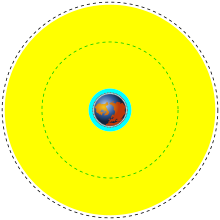
Various earth orbits to scale; cyan represents low earth orbit, yellow represents medium earth orbit, the black dashed line represents geosynchronous orbit, the green dash-dot line the orbit of
Global Positioning System (GPS) satellites, and the red dotted line the orbit of the
International Space Station (ISS).
The first satellite, Sputnik 1, was put into orbit around Earth and was therefore in geocentric orbit. By far this is the most common type of orbit with approximately 2456 artificial satellites orbiting the Earth. Geocentric orbits may be further classified by their altitude, inclination and eccentricity.
The commonly used altitude classifications are Low Earth Orbit (LEO), Medium Earth Orbit (MEO) and High Earth Orbit (HEO). Low Earth orbit is any orbit below 2000 km, and Medium Earth Orbit is any orbit higher than that but still below the altitude for geosynchronous orbit at 35786 km. High Earth Orbit is any orbit higher than the altitude for geosynchronous orbit.
Centric classifications
Altitude classifications

Orbital Altitudes of several significant satellites of earth.
Inclination classifications
Eccentricity classifications
Synchronous classifications
Special classifications
Pseudo-orbit classifications
Satellite modules
The satellite’s functional versatility is imbedded within its technical components and its operations characteristics. Looking at the “anatomy” of a typical satellite, one discovers two modules.[11] Note that some novel architectural concepts such as Fractionated Spacecraft somewhat upset this taxonomy.
Spacecraft bus or service module
This bus module consist of the following subsystems:
- The Structural Subsystems
The structural subsystem provides the mechanical base structure, shields the satellite from extreme temperature changes and micro-meteorite damage, and controls the satellite’s spin functions.
- The Telemetry Subsystems (aka Command and Data Handling, C&DH)
The telemetry subsystem monitors the on-board equipment operations, transmits equipment operation data to the earth control station, and receives the earth control station’s commands to perform equipment operation adjustments.
The power subsystem consists of solar panels and backup batteries that generate power when the satellite passes into the earth’s shadow. Nuclear power sources (Radioisotope thermoelectric generators) have been used in several successful satellite programs including the Nimbus program (1964–1978).[15]
- The Thermal Control Subsystems
The thermal control subsystem helps protect electronic equipment from extreme temperatures due to intense sunlight or the lack of sun exposure on different sides of the satellite’s body (e.g. Optical Solar Reflector)
- The Attitude and Orbit Controlled Control Subsystems
The attitude and orbit controlled subsystem consists of small rocket thrusters that keep the satellite in the correct orbital position and keep antennas positioning in the right directions.
Communication payload
The second major module is the communication payload, which is made up of transponders. A transponder is capable of :
- Receiving uplinked radio signals from earth satellite transmission stations (antennas).
- Amplifying received radio signals
- Sorting the input signals and directing the output signals through input/output signal multiplexers to the proper downlink antennas for retransmission to earth satellite receiving stations (antennas).
End of life
When satellites reach the end of their mission, satellite operators have the option of de-orbiting the satellite, leaving the satellite in its current orbit or moving the satellite to a graveyard orbit. Historically, due to budgetary constraints at the beginning of satellite missions, satellites were rarely designed to be de-orbited. One example of this practice is the satellite Vanguard 1. Launched in 1958, Vanguard 1, the 4th manmade satellite put in Geocentric orbit, was still in orbit as of August 2009.[16]
Instead of being de-orbited, most satellites are either left in their current orbit or moved to a graveyard orbit.[17] As of 2002, the FCC now requires all geostationary satellites to commit to moving to a graveyard orbit at the end of their operational life prior to launch.[18]
Launch-capable countries
This list includes countries with an independent capability to place satellites in orbit, including production of the necessary launch vehicle. Note: many more countries have the capability to design and build satellites but are unable to launch them, instead relying on foreign launch services. This list does not consider those numerous countries, but only lists those capable of launching satellites indigenously, and the date this capability was first demonstrated. Does not include consortium satellites or multi-national satellites.
Notes
- Russia and Ukraine were parts of the Soviet Union and thus inherited their launch capability without the need to develop it indigenously. Through Soviet Union they also are on the number one position in this list of accomplishments.
- France, United Kingdom launched their first satellites by own launchers from foreign spaceports.
- North Korea (1998) and Iraq (1989) have claimed orbital launches (satellite and warhead accordingly), but these claims are unconfirmed.
- In addition to the above, countries such as South Africa, Spain, Italy, Germany, Canada, Australia, Argentina, Egypt and private companies such as OTRAG, have developed their own launchers, but have not had a successful launch.
- As of 2009, only eight countries from the list above ( Russia and Ukraine instead of USSR, also USA, Japan, China, India, Israel, and Iran) and one regional organization (the European Space Agency, ESA) have independently launched satellites on their own indigenously developed launch vehicles. (The launch capabilities of the United Kingdom and France now fall under the ESA.)
- Several other countries, including South Korea, Brazil, Pakistan, Romania, Taiwan, Indonesia, Kazakhstan, Australia, Malaysia[citation needed] and Turkey, are at various stages of development of their own small-scale launcher capabilities.
- South Korea launched a KSLV rocket (created with assistance of Russia) in 25 August 2009, but it failed to put satellite STSAT-2 into precise orbit and the satellite did not start to function.
- North Korea claimed a launch in April 2009, but U.S. and South Korean defense officials and weapons experts later reported that the rocket failed to send a satellite into orbit, if that was the goal.[19][20] The United States, Japan and South Korea believe this was actually a ballistic missile test, which is a claim also made after North Korea's 1998 satellite launch, and later rejected.
Launch capable private entities
- Orbital Sciences Corporation is conducting launches using its Taurus I rocket.
- On September 28, 2008, the private aerospace firm SpaceX successfully launched its Falcon 1 rocket in to orbit. This marked the first time that a privately built liquid-fueled booster was able to reach orbit.[21] The rocket carried a prism shaped 1.5 m (5 ft) long payload mass simulator that was set into orbit. The dummy satellite, known as Ratsat, will remain in orbit for between five and ten years before burning up in the atmosphere.[21]
A few other private companies are capable of sub-orbital launches.
First satellites of countries
While Canada was the third country to build a satellite which was launched into space,[25] it was launched aboard a U.S. rocket from a U.S. spaceport. The same goes for Australia, who launched on-board a donated Redstone rocket. The first Italian-launched was San Marco 1, launched on 15 December 1964 on a U.S. Scout rocket from Wallops Island (VA,USA) with an Italian Launch Team trained by NASA.[26] Australia's launch project (WRESAT) involved a donated U.S. missile and U. S. support staff as well as a joint launch facility with the United Kingdom.[27]
Planned first satellites
 Azerbaijan is developing its space satellite Azerspace. According to the approved plan, Azerspace satellite will be launched into orbit in 2011.[28]
Azerbaijan is developing its space satellite Azerspace. According to the approved plan, Azerspace satellite will be launched into orbit in 2011.[28] Bangladesh announced in 2009 that it intends to launch its first satellite into space by 2011.[29]
Bangladesh announced in 2009 that it intends to launch its first satellite into space by 2011.[29] Croatia has a goal to construct a satellite by 2013–2014. Launch into Earth orbit would be done by a foreign provider.[30]
Croatia has a goal to construct a satellite by 2013–2014. Launch into Earth orbit would be done by a foreign provider.[30] Latvia The project of nano-satellite Venta-1 which will be built in Latvia, in cooperation with the German engineers. The satellite is intended for automatic system of identification of the ships of a sailing charter developed by OHB-System AG. The launch of the satellite was planned for the end of 2009 using the Indian carrier rocket. Due to the financial crisis the launch has been postponed until 2010.
Latvia The project of nano-satellite Venta-1 which will be built in Latvia, in cooperation with the German engineers. The satellite is intended for automatic system of identification of the ships of a sailing charter developed by OHB-System AG. The launch of the satellite was planned for the end of 2009 using the Indian carrier rocket. Due to the financial crisis the launch has been postponed until 2010. Peru is developing its space satellite with the National Engineering University, called Chasqui 1. The nano-satellite will be launched into orbit by 2011, and will have an expected 60-day lifespan. As payload are installed two small VGA cameras. One of both will have a NIR filter.
Peru is developing its space satellite with the National Engineering University, called Chasqui 1. The nano-satellite will be launched into orbit by 2011, and will have an expected 60-day lifespan. As payload are installed two small VGA cameras. One of both will have a NIR filter. Romania announced that it has finished construction of its first satellite, called Goliat. The satellite will be launched into orbit in 2010.[31]
Romania announced that it has finished construction of its first satellite, called Goliat. The satellite will be launched into orbit in 2010.[31] Sri Lanka has a goal to construct two satellites. Sri Lankan Telecommunications Regulatory Commission has signed an agreement with Surrey Satellite Technology Ltd to get relevant help and resources. Launch into Earth orbit would be done by a foreign provider.[32][33]
Sri Lanka has a goal to construct two satellites. Sri Lankan Telecommunications Regulatory Commission has signed an agreement with Surrey Satellite Technology Ltd to get relevant help and resources. Launch into Earth orbit would be done by a foreign provider.[32][33] Tunisia is developing its first satellite, ERPSat01. Consisting of a CubeSat of 1 kg weight, it will be developed by the Sfax School of Engineering. ERPSat satellite is planned to be launched into orbit in 2013.[34]
Tunisia is developing its first satellite, ERPSat01. Consisting of a CubeSat of 1 kg weight, it will be developed by the Sfax School of Engineering. ERPSat satellite is planned to be launched into orbit in 2013.[34]
Attacks on satellites
In recent times satellites have been hacked by militant organizations to broadcast propaganda and to pilfer classified information from military communication networks.[35][36]
As test, satellites in low earth orbit have been destroyed by ballistic missiles launched from earth. Russia, the United States and China have demonstrated the ability to eliminate satellites.[37] In 2007 the Chinese military shot down an aging weather satellite,[37] followed by the US Navy shooting down a defunct spy satellite in February 2008.[38]
Jamming
Due to the low received signal strength of satellite transmissions, they are prone to jamming by land-based transmitters. Such jamming is limited to the geographical area within the transmitter's range. GPS satellites are potential targets for jamming,[39][40] but satellite phone and television signals have also been subjected to jamming.[41][42]
Also, it is trivial to transmit a carrier radio signal to a geostationary satellite and thus interfere with the legitimate uses of the satellite's transponder. It is common for earth stations to transmit at the wrong time or on the wrong frequency in commercial satellite space, and dual-illuminate the transponder, rendering the frequency unusable. Satellite operators now have sophisticated monitoring that enables them to pinpoint the source of any carrier and manage the transponder space effectively.
From:
http://en.wikipedia.org/
Read More..



